Balbharti Maharashtra State Board Class 5 Environmental Studies Solutions Chapter 10 Getting to Know India Notes, Textbook Exercise Important Questions and Answers.
5th Standard EVS 1 Lesson Number 10 Question Answer Getting to Know India Maharashtra Board
Std 5 EVS 1 Chapter 10 Question Answer
1. Correct the following statements and write the answer:
Question (a)
There are coffee plantations in Himachal Pradesh.
Answer:
There are coffee plantations in Kerala.
![]()
Question (b)
Konkan lies in the eastern part of India.
Answer:
Konkan lies in the western part of India.
Question (c)
Jaipur is the smallest state in India.
Answer:
Goa is the smallest state in India.
Question (d)
The Sabarmati river flows through Madhya Pradesh.
Answer:
The Sabarmati river flows through Gujarat.
Question (e)
The Sahyadri mountains are located in Andhra Pradesh.
Answer:
The Sahyadri mountains are located in Maharashtra.
2. Make a chart of the states and the rivers flowing through/in them.
Question 1.
Make a chart of the states and the rivers flowing through/in them.
Environmental Studies Part 1 Standard 5th Solutions Chapter 10 Getting to Know India Additional Important Questions and Answers
Fill in the blanks with the correct answers from the options given below:
Question 1.
India’s …………………. border is defined by the lofty Himalaya ranges.
(a) eastern
(b) northern
(c) western
Answer:
(b) northern
![]()
Question 2.
…………………… is produced on a large scale in central India.
(a) jowar
(b) Wheat
(c) Rice
Answer:
(a) jowar
Question 3.
………………… is the largest state in India.
(a) Maharashtra
(b) Madhya Pradesh
(c) Rajasthan
Answer:
(c) Rajasthan
Question 4.
Telangana state was formed in the year ……………. .
(a) 2013
(b) 2014
(c) 2015
Answer:
(b) 2014
Question 5.
We see several forts along the ………………… coast.
(a) Kerala
(b) Konkan
(c) Karnataka
Answer:
(b) Konkan
Question 6.
Our ……………………. comprises of various rivers, mountains, plateaus, plains, islands etc.
(a) country
(b) nation
(c) state
Answer:
(a) country
Question 7.
The expanse of our country is ………………….. .
(a) small
(b) miniature
(c) large
Answer:
languages
Question 8.
…………………… is a primary crop in the north.
(a) Rice
(b) Wheat
(c) Jowar
Answer:
(b) Wheat
![]()
Question 9.
…………………… is a primary crop in the north.
(a) Rice
(b) Wheat
(c) Jowar
Answer:
(a) Rice
Question 10.
People of many ……………………. castes, tribes and religions live in our country.
(a) different
(b) similar
(c) difficult
Answer:
(a) different
Question 11.
Many different …………………… are spoken in our country.
(a) dress
(b) cuisine
(c) languages
Answer:
(c) languages
Question 12.
India is a democratic ……………………. .
(a) communist
(b) dictator
(c) republic
Answer:
(c) republic
Question 13.
The capital of India is …………………. .
(a) Agra
(b) Maharashtra
(c) New Delhi
Answer:
(c) New Delhi
Question 14.
…………………….. is the second largest state in India.
(a) Andhra Pradesh
(b) Himachal Pradesh
(c) Madhya Pradesh
Answer:
(c) Madhya Pradesh
![]()
Question 15.
…………………… is the third largest state in India.
(a) Tamil nadu
(b) Kerala
(c) Maharashtra
Answer:
(c) Maharashtra
Question 16.
…………………….. is the smallest state in India.
(a) Assam
(b) Goa
(c) Jammu
Answer:
(b) Goa
Match the following:
Question 1.
Match the following:
| ‘A’ | ‘B’ |
| 1. Lakshadweep islands | (a) Bay of Bengal |
| 2. Andaman & Nicobar | (b) Indian mainland |
| 3. Coastal Islands | (c) Arabian sea |
Answer:
| ‘A’ | ‘B’ |
| 1. Lakshadweep islands | (c) Arabian sea |
| 2. Andaman & Nicobar | (a) Bay of Bengal |
| 3. Coastal Islands | (b) Indian mainland |
![]()
Answer in one word:
Question 1.
Answer in one word:
- A primary crop in the north.
- A primary crop in the south.
- Capital of India
- Second longest state of India.
Answer:
- Wheat
- Rice
- New Delhi
- Madhya Pradesh.
Write in one sentence:
Question 1.
Which part of India is called the Indian peninsula?
Answer:
The Indian subcontinent is surrounded by water on three sides and tapers towards the south. This part is called the Indian peninsula.
Question 2.
How does natural diversity affect human beings?
Answer:
Natural diversity affect our lifestyle, customs, traditions and culture.
Question 3.
What diversity is found with regards to people in our country?
Answer:
People of different castes, tribes, religion and speaking different languages live in our country.
Question 4.
What does our country comprise of?
Answer:
Our country comprises of various rivers, mountains, plateau, plains, islands etc.
![]()
Question 5.
What covers our northern border?
Answer:
Our northern border is defined by the lofty Himalayan ranges.
Question 6.
What is the height of India’s land?
Answer:
The height above sea-level goes beyond 8000 metres.
Question 7.
Which is the primary crop grown in north India?
Answer:
Wheat is the primary crop grown in north India.
Question 8.
Which is the primary crop grown in south India?
Answer:
Rice is the primary crop grown in south India.
Question 9.
Which crop is grown on a large scale in central India?
Answer:
Jowar is grown on a large scale in central India.
Question 10.
What makes the islands in the Arabian Sea, Bay of Bengal very important?
Answer:
These islands have strategic location from defence point of view.
Question 11.
What are sea forts?
Answer:
Sea forts are forts built on an island off the coast to safeguard* the coast.
Give geographical reasons:
Question 1.
In India, the weather conditions change from region to region.
Answer:
1. The expanse of our country is large.
2. The height above sea level varies and goes up even beyond 8000 metres.
3. Therefore, the weather conditions change from region to region.
Study the physical map of India carefully and answer the questions:
Question 1.
Find the mountains and name them.
Answer:
The Himalayas, The Sahyadris, The Satpuda, The Vindhya range, Aravalli range.
Question 2.
Name the hills shown on the map.
Answer:
Nallamala hills, Mahedragiri, Malaygiri.
![]()
Question 3.
Find and name the plateaus in the map.
Answer:
Deccan Plateau, Telangana, Chotta Nagpur Plateau, Karnataka Plateau, Malwa Plateau.
Question 4.
Which rivers originate in the Himalayas and join the Indus? Consider the height and write the direction of their flow.
Answer:
River Jhelum, River Ravi, River Chenab and River Satluj join River Indus. They flow to the south.
Question 5.
Write the names of the major rivers which flow into the Coromandel Coast.
Answer:
River Kaveri and River Krishna.
Question 6.
Study the course of the Ganga, Narmada, Vainganga, Godavari and Kaveri rivers. Note the slope of the land in each basin and write the direction of the slope.
Answer:
River Ganga flows eastwards, River Narmada flows westwards, Vinganga flows southwards, Godavari and Kaveri flow eastwards.
Question 7.
Find the lakes on the map and name them.
Answer:
Wular, Dal, Chilka, Kolleru, Lonar and Pulicat Lake.
Question 8.
Find and name the gulfs and the direction in which they are located with respect to India.
Answer:
Gulf of Kachchh and Gulf of Khambhat in Gujarat (west), Gulf of Mannar in the south.
![]()
Question 9.
Study the water bodies on the three sides of India. Find their names and write the direction in which they are located.
Answer:
Arabian sea to the west, Bay of Bengal to the east and Indian ocean to the south.
Question 10.
Find the Lakshadweep, Andaman and Nicobar Island groups and write the names of some of the islands.
Answer:
In the Lakshadweep lies Chettlon, Andron, Kalpeni, Tree island. In the Andaman and Nicobar Islands lie Car Nicobar, South Andaman, Coco Island, North Andaman and Middle Andaman.
Question 11.
Which river basin is located in the northern plain of India?
Answer:
To the North of India lies the river basin of Ganga.
Study the political map of India given below and answer the questions:
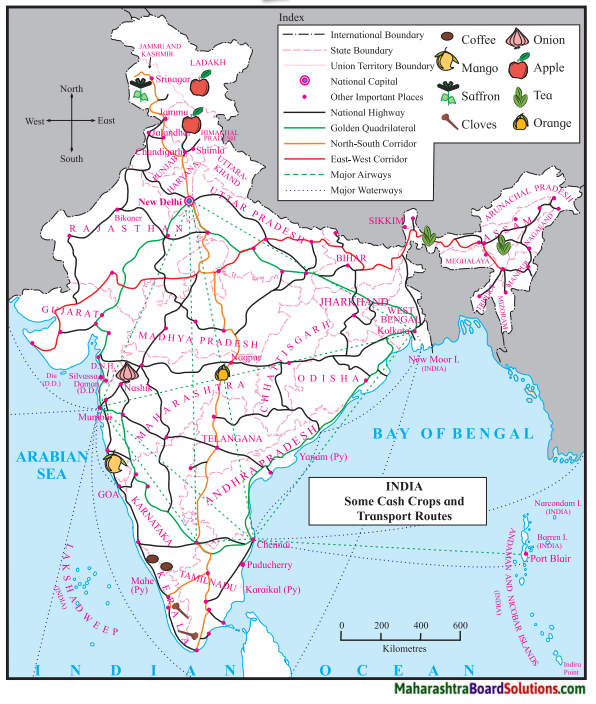
Question 1.
Find our State. Colour it with your favourite colour and write the name of its capital.
Answer:
Maharashtra (Capital is Mumbai) colour it in red.
![]()
Question 2.
Which is the northernmost State?
Answer:
Jammu and Kashmir
Question 3.
Which is the southernmost State?
Answer:
Tamil Nadu
Question 4.
Colour the States to the north-east in different colours. Write their names and the names of their capitals.
Answer:
| Name of State | Capital | Colour |
| (a) Arunachal Pradesh | Itanagar | Blue |
| (b) Assam | Dispur | Green |
| (c) Meghalaya | Shillong | Yellow |
| (d) Nagaland | Kohima | Pink |
| (e) Manipur | Imphal | Purple |
| (f) Mizoram | Aizawl | Black |
| (g) Tripura | Agartala | Orange |
Question 5.
Colour the largest State in yellow and circle its capital.
Answer:
Colour Rajasthan in yellow and circle its capital Jaipur.
Question 6.
What do the names in red letters show?
Answer:
Names in red letters show Union territories.
![]()
Use your brain power!
Question 1.
Which is the State next to us which was formed in 2014?
Answer:
Telangana State
Question 2.
How many States are there in India?
Answer:
29 states
Question 3.
In which State is the Great Indian Desert mainly located?
Answer:
Rajasthan
Answer the questions given below with the help of map.
Question 1.
From where will we obtain saffron? Trace the most convenient route.
Answer:
We obtain saffron from Jammu and Kashmir. (Route from Srinagar – Chandigarh – New Delhi – Gujarat – Maharashtra)
Question 2.
In which States is tea grown?
Answer:
West Bengal and Assam
![]()
Question 3.
Find the route taken to bring cloves into our State and trace it.
Answer:
Cloves can be brought from Kerala – Karnataka – Goa – Maharashtra
Question 4.
Find the States in which apples are grown. Circle their names.
Answer:
Jammu and Kashmir and Himachal Pradesh.
Question 5.
Find the route to deliver oranges from Nagpur to Bikaner and trace it.
Answer:
Nagpur – Madhya Pradesh – Bikaner
Question 6.
Find a route to deliver coffee and mangoes to West Bengal and trace it.
Answer:
Coffee from Kerala – Chennai – Andhra Pradesh – Odisha – West Bengal.
Mangoes from Maharashtra
Nagpur – Chattisgarh – Odisha – West Bengal.
![]()
Question 7.
How will you send onions from Maharashtra to Arunachal Pradesh?
Answer:
Nashik – Nagpur – Chhatisgarh – Odisha – West Bengal – Assam – Arunachal Pradesh.
What’s the solution?
Question 1.
Harsh and Tanishka live in Mumbai. They want to see the Andaman and Nicobar islands. First they are going to see their uncle in Chennai. After that, they will visit the islands. To make this trip, which of the routes on the map on page 49 will they have to take? Will you help them by tracing this route on the map?
Answer:
Harsh and Tanishka can travel to Andaman and Nicobar by seaways as shown in the map with black dotted lines or by airways shown with green dash line. They can reach Port Blair.
![]()
Glossary:
1. tapers – diminish or reduce in thickness at one end.
2. lofty – of imposing height.
3. Cuisine – style or method of cooking.
Class 5 Environmental Studies Questions and Answers:
- Our Earth and Our Solar System Class 5 Questions And Answers
- Motions of the Earth Class 5 Questions And Answers
- The Earth and its Living World Class 5 Questions And Answers
- Environmental Balance Class 5 Questions And Answers
- Family Values Class 5 Questions And Answers
- Rules Are for Everyone Class 5 Questions And Answers
- Let us Solve Our own Problems Class 5 Questions And Answers
- Public Facilities and My School Class 5 Questions And Answers
- Maps – Our Companions Class 5 Questions And Answers
- Getting to Know India Class 5 Questions And Answers
- Our Home and Environment Class 5 Questions And Answers
- Food for All Class 5 Questions And Answers
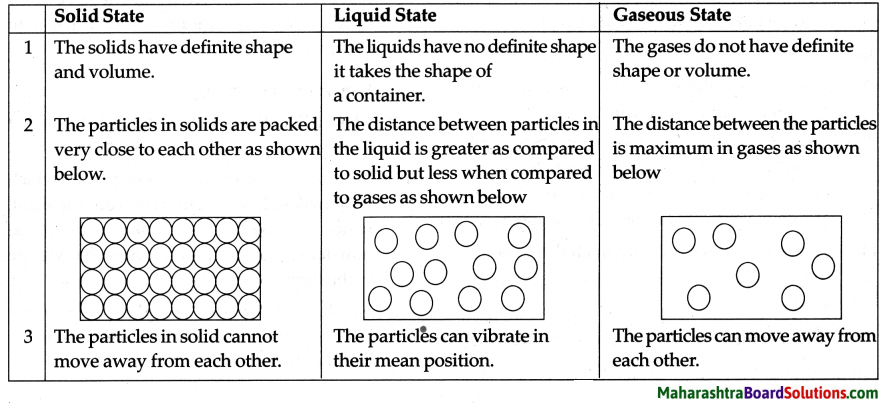
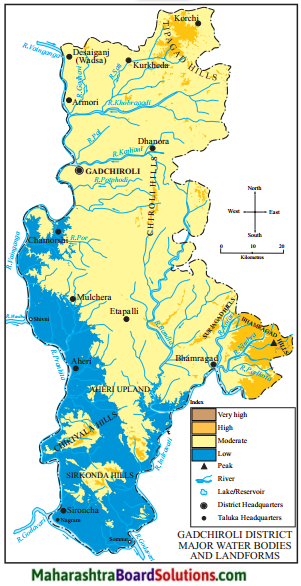
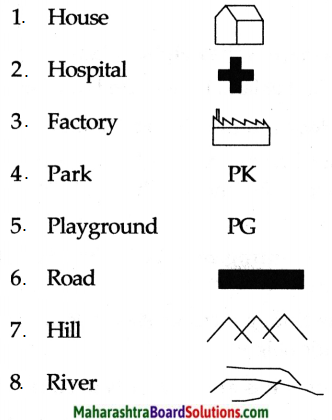
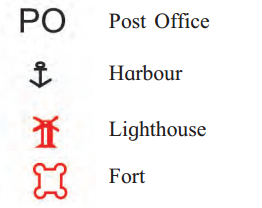
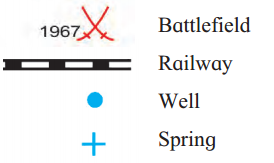
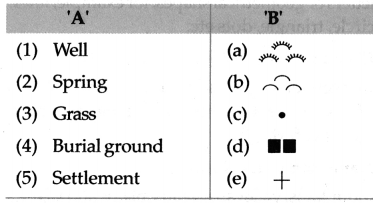
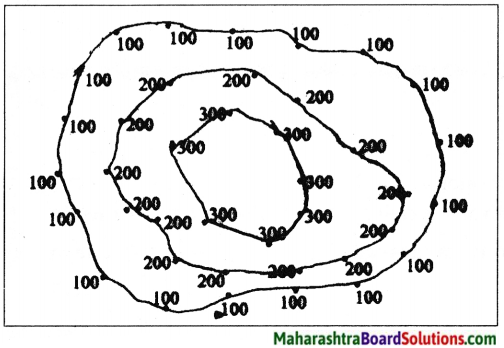
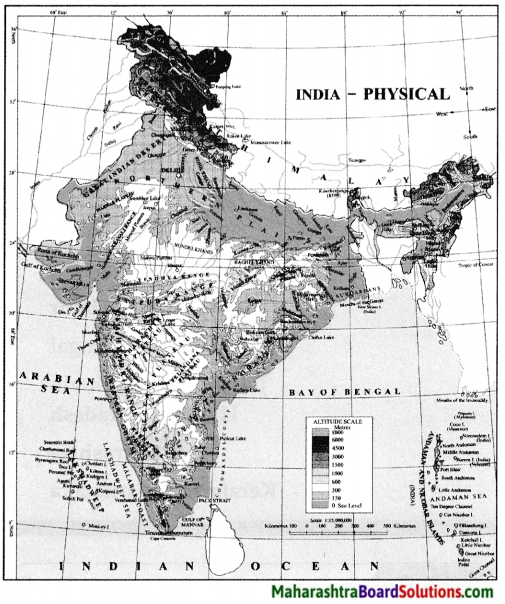



 Answer:
Answer: